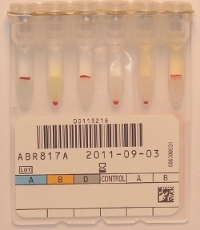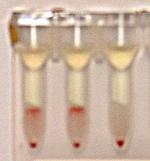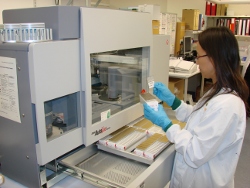Alert!
- If you need blood urgently, please telephone Blood Bank immediately!
- For emergency transfusions, Blood Bank has various strategies to provide blood as rapidly and as safely as possible. See Emergency Blood
- Group and screen results are only valid at the Blood Bank where the testing was conducted. If your patient has come from somewhere else with a different Blood bank, you will need to send a new sample to your Blood Bank.
- Cord blood samples are not suitable for crossmatching due to the presence of Wharton's jelly.

An ABO/D card from an A positive patient
- All pretransfusion samples are tested for the ABO blood group and the Rh(D) blood group.
- This is critical for preventing haemolytic transfusion reactions.
- This is typically tested with the antibody screen so takes approximately 40 minutes# but can be performed separately and faster in an emergency.
- The results of these tests are compared with the patient's previous test results at this and other Blood Banks.
- ABO is tested because all patients will have pre-formed ABO antibodies
- Rh(D) is tested because it is highly immunogenic and the anti-D antibody is highly potent once formed.
- All pretransfusion samples are tested for antibodies to the other clinically significant blood groups.
- There are 29 known blood group systems, each with more than one antigen.
- For example, Rh is a blood group system, c, C, D, e and E are antigens within the Rh system.
- This is critical for preventing haemolytic transfusion reactions.
- This is performed by using the red cells from three different donors whose blood groups combined cover the full spectrum of clinically significant blood groups.
- This takes approximately 40 minutes# and is typically tested simultaneously with the ABO/Rh(D) blood grouping. Because of the nature of the test, testing time cannot be shortened.
- The test takes this long because there is a long incubation period to allow antibodies in the patient's plasma to attach to the donor red cells.
- If the antibody screen is positive, antibody identification is needed.

A positive antibody screen: clumps of agglutinated red cells in left two columns do not travel to bottom of of column
- If the antibody screen is positive, an antibody panel of 11 different donors' red cells is used to identify which antibody is present.
- This is critical for preventing haemolytic transfusion reactions.
- This is typically a manual test and takes approximately 40 minutes#. Once the antibody has been identified, further time will be required to identify suitable units.
- The test takes this long because there is a long incubation period to allow antibodies in the patient's plasma to attach to the donor red cells.
- If the patient has been blood grouped twice (to exclude any errors) and has no antibodies on antibody screening, blood can be issued immediately by electronic crossmatch.
- This is an electronic crossmatch because the Blood Bank computer system performs a number of crosschecks between the patient's results and the units for issue. If these checks are okay, the units can be issued as fully compatible.
- For patients with no antibodies on antibody screening, blood does not have to be specifically put aside as all the ABO/D group-compatible blood in the bank is immediately available for issue.

An automated blood group analyser
- Where a patient has antibodies identified on screening, a full crossmatch is needed.
- A full crossmatch involves mixing the patient's plasma with red cells from the unit and looking for a reaction.
- The test takes 40 minutes# because there is a long incubation period to allow antibodies in the patient's plasma to attach to the unit's red cells.
- Multiple units can be crossmatched at a time, but Blood Bank will need to know how many are required to decide how many units to test.
- Where a patient has antibodies identified on screening, only fully crossmatch units can be issued as fully compatible.
- For some antibodies, a further step is also required, namely confirming that the unit red cells are negative for the antigen that the antibody is directed against.
- Times provided above are the minimum time required to perform the test and do not include associated tasks.
- The time to complete the test also varies depending on workload and case priorities.